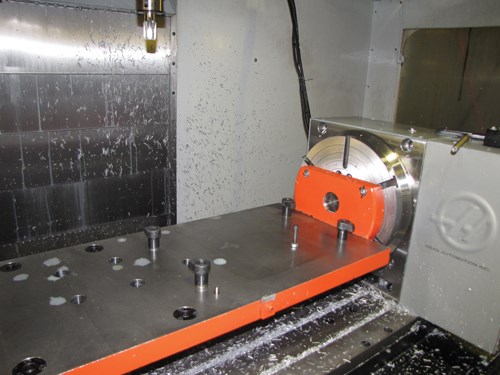Bolt-On Trunnion Tables
Trunnion tables can be a low-cost way to reduce part handling, speed throughput and improve accuracy at a fraction of the cost of new machines.
Keeping the shop floor equipped with the latest technology is a challenge for any company, but having the capabilities to deliver is necessary to gain new business as well as maintain existing customers. When a shop looks to upgrade, either by retrofit of existing machines or purchase of new equipment, it often faces steep costs on top of extensive (that is, expensive) downtime. Return on investment can take months or even years.
Trunnion tables can be a low-cost way to reduce part handling, speed throughput and improve accuracy at a fraction of the cost of new machines. Standard sizes accommodate popular vise models, and made-to-order sizes are also available. The Stallion 9\20 and 9\23 tables from TrunnionTable.com allow users to exploit the rotary fourth-axis capability of horizontal and vertical machining centers, delivering a low-cost path to higher productivity and improved accuracy. They allow machining of multiple sides of a part without ever unclamping it, turning a VMC into a horizontal machine.
Details
The bolt-on trunnions are work-ready right out of the box, with standard-sizes designed for the most common models of Kurt vises, including the DL675, DL688, DL640 and all high-density models. The workholding devices reduce part handling and setups and allow more parts to be loaded and machined on more sides, delivering immediate ROI for job shops and other mid-range production environments. The trunnion fixtures are engineered to bolt on to any machine’s rotary indexer, allowing operators to precisely mill, drill, tap and contour up to three sides of a part in one setup without special fixtures and without the need for cumbersome clamps and vises that can create costly downtime. Heavily ribbed cast iron construction provides high rigidity and durability, helping to withstand long-term repeated use in demanding shop environments.
The Stallion 9\20 (9 inches by 20 inches) and 9\23 (9 inches by 23 inches) rotary models have outboard supports customized to the centerline of a machine’s indexer. The 9\20 model holds a single 6-inch vise, while the 9\23 model holds a double- or single-station 6-inch vise. Both incorporate a through hole for the vise handle. The Stallion 9\23 is also available in double-sided (9\23\DS) and quick-change (9\23\QC) versions. The double-sided table enables machining on six sides, while the quick-change table enables 60-second change-overs with ±0.0005-inch repeatability.
Built for precision as well as durability, the tables have 0.001-inch flatness over 23 inches and 0.001-inch squareness to the faceplate. “The fastest, easiest, least expensive way to get higher productivity, better part quality and a boost to the bottom line out of four-axis machining centers is to add a bolt-on trunnion table,” says Stan Martin, president of TrunnionTable.com. “We have customers who have paid for the tables in just days through the increased throughput and reduced work in progress.”
Workholding Options
In addition to the ready-made standard sizes, TrunnionTable.com also offers quick turnaround for custom sizes and configurations, including a Large Series Table with a 3,500-lb hydraulic brake for extreme brake torque to eliminate twisting and machine chatter.
The trunnion tables, which can be installed in minutes, provide a workholding solution that can have an immediate impact on a shop’s productivity through reduced setup time and higher productivity.
Related Content
Parting Off: The Case for Standardizing on Sawing
The value of rotary saw cutting for parting off operations could boil down to simple economics paired with process efficiency gains.
Read MoreBroaching Tool Technology For Lathes Used to Slot Inconel Parts
This shop finds value in using an indexable-insert-style broaching tool to create blind-hole slots in heat-treated Inconel aerospace parts on a CNC lathe.
Read MoreMaking Micro Threads
Production of micro threads can be challenging, but using the most suitable tools for a given application can simplify the task.
Read MoreShop Sets its Sights on Precise Tool Alignment
A Wisconsin shop has found that visual tool alignment technology has improved tool life and surface finishes for its Swiss-type lathes while increasing throughput as well.
Read MoreRead Next
The Many Sides of Workholding
Here's a broad look at different ways to approach workholding, from bar feeders to collet chucks to robotics.
Read More5 Aspects of PMTS I Appreciate
The three-day edition of the 2025 Precision Machining Technology Show kicks off at the start of April. I’ll be there, and here are some reasons why.
Read MoreEmerging Leaders Nominations Now Open
Here’s your chance to highlight a young person in your manufacturing business who is on the path to be a future leader moving your company forward.
Read More












.jpg;maxWidth=300;quality=90)











